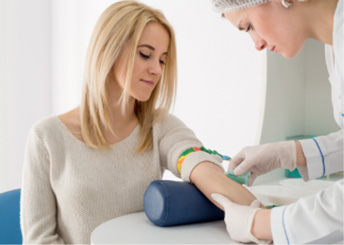
A Non-Invasive Prenatal Test (NIPT, for short) can also sometimes be called a Non-Invasive Prenatal Screening (NIPS). This is a method used to determine the risk of a fetus being born with certain genetic abnormalities.
How Does a NIPT or NIPS Work?
This testing method analyzes small fragments of DNA that are circulating in the pregnant woman’s blood. During pregnancy, a mother’s blood contains a mixture of cell-free DNA (cfDNA) that comes from both her cells and the cells from the placenta. The placenta is tissue in the uterus that links the mother’s blood supply to the fetus. Cell-free DNA, is a certain type of DNA that is free-floating and not within a cell, unlike most DNA which is found inside a cell’s nucleus. Throughout a woman’s pregnancy, cell-free DNA is often shed into the mother’s bloodstream. These placental cells contain DNA usually identical to the fetus’ DNA. By analyzing this cell-free DNA from the placenta, expecting mothers are provided an opportunity to find early detection of certain genetic abnormalities.
How is the NIPT Administered?
A pregnant woman at 10 to 13 weeks, can get a Non-Invasive Prenatal Test by getting their blood drawn. This test poses no risk to the mother or their baby. The blood sample is then sent to a lab where technicians analyze the results and report the findings back to the ObGyn. Results can be expected within 8 to 14 days from when they are sent.
What Abnormalities Can NIPT or NIPS Detect?
With a Non-Invasive Prenatal Test, pregnant women are able to determine the risk of disorders including Trisomy 21, also known as Down Syndrome, in addition to Trisomy 18 (Edwards Syndrome), and Trisomy 13 (Patau Syndrome). Other conditions caused by missing or additional X and Y chromosomes can also be detected with a NIPT or NIPS. More advanced NIPTs may be customized to screen for extra abnormalities.
How Accurate Are These Tests?
A NIPT offers more precise information earlier while featuring a low false-positive rate. About one in 1,000 people get a false-positive rate. While this test is not 100% accurate and should not be used as a final diagnosis for positive cases, in a 2016 Study, it was found that the NIPT has very high sensitivity and specificity for Down Syndrome and a slightly lower sensitivity for Edwards and Patau Syndrome. NIPTs are often considered 99% accurate.
Who Should Get a NIPT or NIPS?
There are many women who chose to have testing. Some reasons you may choose to get a NIPT include:
- An ultrasound brings concern regarding the baby’s growth or development.
- You are at increased risk due to pregnancy at an older age or you have a personal or family history of a pregnancy with a chromosomal abnormality.
- You would simply like to have more information.
Is a NIPT Affordable?
If you have increased risk factors for chromosomal abnormalities and your ObGyn orders a test, your insurance may cover part of all of the cost of the NIPT. Check with your doctor and insurance provider before the test is administered to determine the price of the NIPT and how much will be covered, if any, by your insurance. At this time the NIPT is considered an elective screening.
Have Additional Questions About Non-Invasive Prenatal Testing?
If you have additional questions about Non-Invasive Prenatal Testing, please contact Kansas City ObGyn today at This email address is being protected from spambots. You need JavaScript enabled to view it. or 913-225-8605.
Dr. Errick Y. Arroyo, MD is a physician at Kansas City ObGyn. He received his medical degree from the University of Kansas School of Medicine and has been practicing for more than 20 years. He is married and has two teenage daughters.






